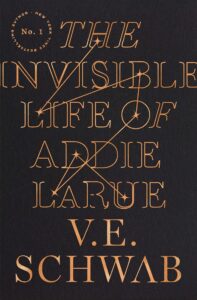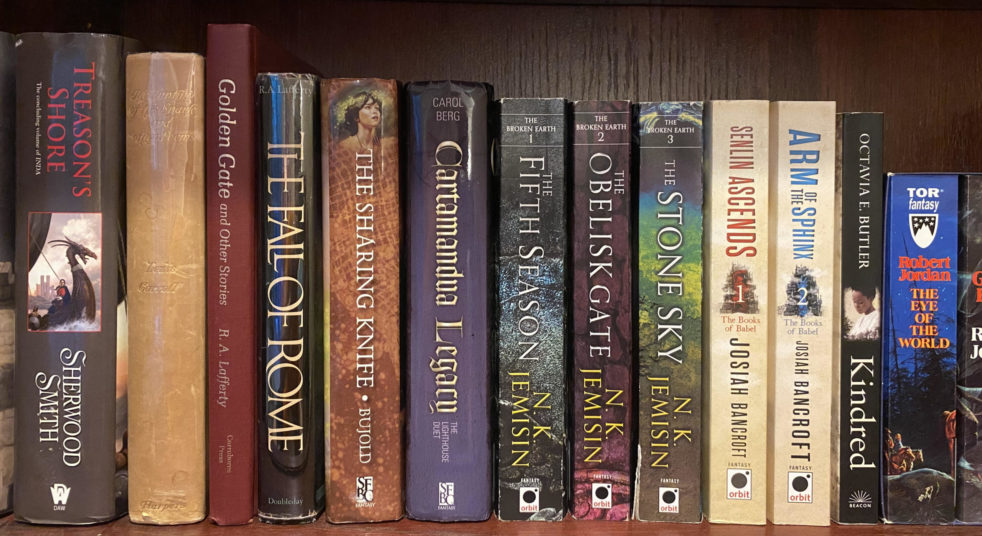
V.E. Schwab has a huge readership, and The Invisible Life of Addie LaRue was all over the place in 2020, but it passed me by at the time, and didn’t give much thought to circling back until it was picked up by my in-person book club this year. My online friends had wildly disparate responses, so I was curious to see how it would hit for me.
The Invisible Life of Addie LaRue is a Faustian bargain story with a bit of a twist. An 18th century French woman, beloved of a father who flouted tradition to teach her to read and bring her on business trips, finds herself terrified at the loss of freedom that would come with a marriage. And so she makes a deal with a devil, gaining freedom from earthly encumbrance in exchange for her soul. But that freedom from being tied down comes with a barb: all her actions fade away shortly after she performs them. She doesn’t age, her injuries fade, she cannot build things, and she’s quickly forgotten by everyone she meets. And so her life soon becomes an obsession with making her mark in the world, while the devil she’s dealt with prods her into giving up and ceding her soul.
The Invisible Life of Addie LaRue is split into seven parts, each opening with the description of a piece of art that Addie has somehow inspired. But while the attempts to influence artists are a constant subplot threading through all seven sections, this is fundamentally a two timeline story with two major plotlines, with the temporal and geographical setting jumping back and forth every couple chapters. The older, wider story is that of Addie’s slow-building battle over the terms of her bargain. There’s a devil after her soul, and she doesn’t want to give him the satisfaction. The contemporary story, on the other hand, is the romantic tale of her time with the one human who somehow can remember her.
While The Invisible Life of Addie LaRue weighs in around 450 pages, the individual chapters are short, and it’s an easy read that doesn’t demand much of the reader. The prose is high-quality—with occasional moments where it’s a hair too aware of the fact—and extremely readable, and both timelines offer enough little conflicts along the way to the bigger arcs to keep things engaging. Early in the older timeline, Addie is mostly concerned with surviving and learning the bounds of her curse, which lend an immediacy to the action. Later, she’s more concerned with finding a way to make a mark on the world, but that’s also an interesting storyline that’s cleverly brought out in the section divisions.
Once the bigger story arcs begin to take shape, the timelines progress into stories that share a few elements but hit quite differently. The contemporary tale is safe and familiar but is well-executed and nails the climactic notes, whereas the wider arc is a bit more ambitious but doesn’t totally land. The former introduces a love interest without a whole lot of personality on his own but who fits well enough with Addie and paves the way for some major developments in her story. I could see some of the big plot beats coming, but they were told in such a compelling way that it didn’t hurt the story at all. If anything, seeing them coming made me more invested in the read, with the anticipation keeping the pages turning quickly. There’s something to be said for a story that’s familiar but well-executed.
On the other hand, while I appreciated the ambitions of the wider story, there are a few nagging points that kept it from fully landing. First of all, in a world with devils but without any indication that heaven is real, the cost of selling one’s soul seemed strangely understated, robbing that tale of some of its stakes. But more importantly, the development of the devil character’s obsession with Addie seemed strange and discordant with his power and tendency to hold himself above human concerns. Certainly, he’s not the only god to develop an obsession with a mortal, but his story didn’t build in a way that I found convincing as a reader. And so even though that story arc ends in an interesting place, I could never fully buy in to it.
Overall, that leaves me with mixed feelings about The Invisible Life of Addie LaRue. One storyline is a little predictable but highly engaging, and the other is more ambitious but doesn’t fully land. Ultimately, the quality of the prose, ease of reading, and the impact of the climactic scenes leaves me positively disposed toward the book, but while there are plenty of readers who will doubtless love this one, it’s not a book that demands shooting to the top of a crowded TBR.
Recommended if you like: good prose that’s easy to read, bargain stories with romantic subplots.
Can I use it for Bingo? It’s hard mode for Gods and Pantheons and Book in Parts. It also has Epistolary segments, an LGTBQIA Protagonist, and elements of High Fashion.
Overall rating: 14 of Tar Vol’s 20. Four stars on Goodreads.
